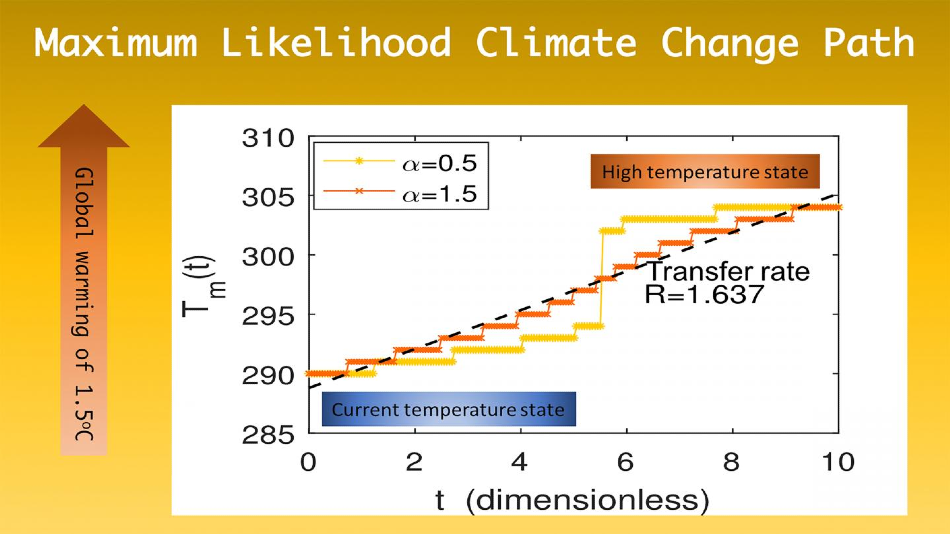Jan 23 2020
According to the Global Climate Change website of NASA, the temperature of the Earth has increased by 1.9 °F since 1880, and this trend is expected to continue further.
 The maximum likelihood transition from the current temperature state to the warmer one for global warming, under the influence of Levy noise and the greenhouse effect. (Y-axis is the temperature in Kelvin; X-axis is time in undetermined segments). Image Credit: Yayun Zheng.
The maximum likelihood transition from the current temperature state to the warmer one for global warming, under the influence of Levy noise and the greenhouse effect. (Y-axis is the temperature in Kelvin; X-axis is time in undetermined segments). Image Credit: Yayun Zheng.
Researchers are actively looking for ways to perceive this change and figure out its impact on residents and the ecosystems of Earth.
In AIP Publishing’s Chaos, researchers Yayun Zheng, Fang Yang, Jinqiao Duan, Xu Sun, Ling Fu, and Jürgen Kurths have described an in-depth study on shifts relating to climate change, explaining the mechanisms behind sudden changes in global weather.
It is very difficult to predict a significant transition, like climate change. However, the probabilistic framework devised by the researchers represents the first step in finding the path between a transition in two environmental states.
A climate change model based on the probabilistic framework was subsequently developed by the scientists. This was done to analyze the maximum possibility of climate change for an energy balance system under the impact of Lévy fluctuations and the greenhouse effect.
Such fluctuations, which present themselves as large solar outbreaks or volcanic eruptions, for instance, are proposed to be one factor that can activate a sudden climatic transition.
The sudden climate changes that took place around 25 times during the last glacial period were the outcome of these noise fluctuations. The glacial period refers to a series of pauses in geophysical turbulence. Another outcome of the noise fluctuations is the production of proteins in gene regulation, which takes place in bursts.
Although the climate changes may not easily be accurately predicted, we offer insights about the most likely trend in such changes for the surface temperature. In the present paper, we have uncovered that the maximum likelihood path, under an enhanced greenhouse effect, is a step-like growth process when transferring from the current temperature state to the high temperature one.
Jinqiao Duan, Professor and Director, Department of Applied Mathematics, Illinois Institute of Technology
Interpreting the step-like growth process of the greenhouse effect can allow the researchers to map out the path that may be taken by climate change. The scientists discovered that greater effects of noise fluctuations could lead to sudden transitions from a cold climate state to a warmer state.
The maximum likelihood path will be expected to be an efficient research tool, in order to better understand the climate changes under the greenhouse effect combined with non-Gaussian fluctuations in the environment.
Jinqiao Duan, Professor and Director, Department of Applied Mathematics, Illinois Institute of Technology
The article titled “The maximum likelihood climate change for global warming under the influence of greenhouse effect and Lévy noise” was written by Yayun Zheng, Fang Yang, Jinqiao Duan, Xu Sun, Ling Fu, and Jürgen Kurths.